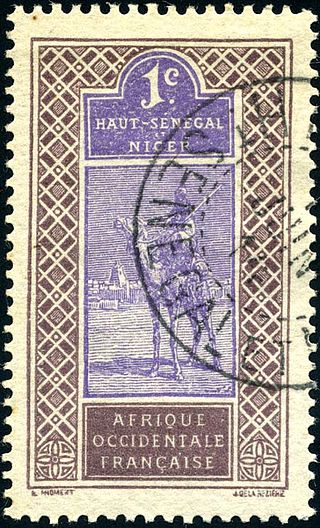Upper Senegal and Niger
French colony in West Africa (1904-21) From Wikipedia, the free encyclopedia
French colony in West Africa (1904-21) From Wikipedia, the free encyclopedia
Upper Senegal and Niger (French: Haut Sénégal et Niger) was a colony in French West Africa, created on 21 October 1904 from colonial Senegambia and Niger by the decree "For the Reorganisation of the general government of French West Africa".[1]
Colony of Upper Senegal and Niger | |||||||||||||
|---|---|---|---|---|---|---|---|---|---|---|---|---|---|
| 1904–1921 | |||||||||||||
 A map of Upper Senegal and Niger circa 1912 from french colonial report | |||||||||||||
| Status | Colony in French West Africa | ||||||||||||
| Capital | Bamako | ||||||||||||
| Common languages | French | ||||||||||||
| History | |||||||||||||
• Established | 1904 | ||||||||||||
• Disestablished | 1921 | ||||||||||||
| Currency | French West African franc | ||||||||||||
| |||||||||||||
| Today part of | Burkina Faso Mali Niger | ||||||||||||
At its creation, the "Colony of Upper Senegal and Niger" contained the old territories of Upper Senegal, the Middle Niger, and the military Niger territory. Its capital was Bamako.
From early on Upper Senegal and Niger was wracked by violence in the face of colonial reorganization and taxation. Most notable were the Kobkitanda rebellion, led by the blind cleric Alfa Saibou, and the Karma revolt (December 1905–March 1906) of Oumarou Karma. The latter engulfed much of the Niger valley and was suppressed by four French columns arriving from Dori, Gao, Tahoua, and Zinder.[2]
A decree of 2 March 1907 added the cercles of Fada N'gourma and Say, which had been part of the colony of French Dahomey (present-day Benin).[3] On 1 January 1912, the military territory of Niger was split off from Upper Senegal and Niger,[4] and was erected into a colony in 1922.
Between November 1915 and February 1917, the Colony of Upper Senegal and Niger witnessed vastly popular, temporarily successful, and sustained armed opposition to the colonial government in its western Volta region, which is referred to as the Volta-Bani War. It challenged colonial government authority for more than a year in an area stretching from Koudougou (in present-day Burkina Faso) in the east, to the banks of the Bani River (present-day Mali) in the west.[5] This was the most significant armed opposition to colonial authority organized anywhere in sub-Saharan Africa in the period preceding World War II.
After World War I ended, the unsuspected success of this resistance movement caused the French authorities to issue the decree "Concerning the Division of the Colony of Upper Senegal and Niger and the Creation of the Colony of Upper Volta" of 1 March 1919, which divided the colony into two distinct units:[6]

The colony of Upper Senegal and Niger is perhaps remembered most often by philatelists since it issued a number of postage stamps during its existence.
Seamless Wikipedia browsing. On steroids.
Every time you click a link to Wikipedia, Wiktionary or Wikiquote in your browser's search results, it will show the modern Wikiwand interface.
Wikiwand extension is a five stars, simple, with minimum permission required to keep your browsing private, safe and transparent.